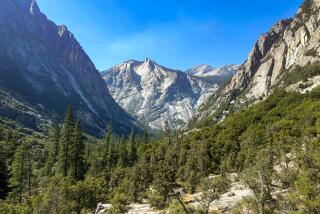Pinnacles and Needles : Rangers at National Monument Are Worried That an Earthquake Could Topple Boulders Over Caves
PINNACLES NATIONAL MONUMENT, Calif. — Two National Park Service rangers stood beneath the gigantic boulder wedged inside a narrow canyon. They were checking it for any movement.
“What a time for an earthquake,” joked Steve Debenedetti, park resources manager.
Every week since October, when the caves were reopened after being closed for nine months, rangers at Pinnacles National Monument 60 miles southeast of Monterey have been monitoring a network of boulders that form the roofs of two caves in the park. The rangers use a highly accurate measuring device called a tape extensometer.
Formed Over the Centuries
Quarter-mile-long Bear Gulch Cave and 300-foot-long Balconies Cave were formed over the centuries by an aggregation of differently shaped boulders sliding down narrow canyon walls and wedging against each other near the canyon bottom.
When a boulder about six feet in diameter fell from the ceiling of Balconies Cave in March, 1983, the Park Service sealed the caves with iron gates. It was the first time in 75 years--since establishment of the monument by President Theodore Roosevelt--that part of a roof of one of the caves had collapsed. No one was hurt.
The huge rock was jarred loose during a three-day storm. Seven inches of rain pelted the park, and streams meandering through the caves became rushing torrents.
Authorities feared that other rocks and boulders might fall, particularly since the caves sit on top of a particularly active segment of the San Andreas Fault, and earthquakes occur here frequently.
“We seriously considered sealing the caves permanently,” said Edward R. Carlson, the chief ranger. “But the caves are the highlight of the national monument. The caves are what bring people here. We received hundreds of complaints about the closure.”
About 50,000 visitors to the monument each year use the trails in the caves, some sections of which have to be crawled through. Other parts of the caves open into large rooms.
After the decision was made to reopen the caves, a seismograph was installed at the park visitors’ center.
Immediately Measured
If seismic activity of 2.0 or greater on the Richter scale is noted, all the critical points in the cave are immediately measured. If significant rock movement is detected or high water conditions exist, the caves will be closed until conditions are stable, Carlson said, adding that the monitoring program will continue indefinitely.
Stability of the caves is not the only source of concern for rangers at the Pinnacles National Monument.
They are also upset about an exploding population of between 40 and 50 wild hogs that are “rooting up monument trails and tearing apart plants,” according to Debenedetti. And, rangers say, local ranchers insist on grazing their cattle on monument land.
“Our mandate is to manage the park in its natural state; we’re not in the business to manage this resource as a ranch,” Debenedetti said.
To cope with the animal problem, the park service wants to erect a 23-mile, $556,000 wire fence around the monument. But the plan has met with opposition from other government agencies and from local citizens. The San Benito County Board of Supervisors recently voted to oppose the fence.
“The fence would be a plain waste of taxpayers’ money,” said Supervisor Rocky Lydon, who until his retirement was a farm adviser for the University of California. “That fence isn’t about to stop hogs. Hogs will dig holes underneath it, go through it.”
Wild hogs were introduced into California in the 1920s by a private hunting club.
Concern for Deer
Don Pine, a wildlife biologist for the California Department of Fish and Game, and David Howell, area manager for the U.S. Bureau of Land Management, contend that the fence would harm the local deer population. Adult deer, but not fawns, would be able to jump over the fence, they said, and the young ones would starve or fall prey to coyotes.
Pine said the park service should either allow hunters to shoot the hogs, have dogs drive them out of the park or trap them.
But the park service’s Carlson said hunting wild hogs in a national monument would provoke the same kind of public reaction as did shooting wild burros in Death Valley and the Grand Canyon.
Some critics of the park service have suggested that rangers round up and sell any cattle that wander on national park land if the neighboring ranchers are unable to care for their own animals.
More to Read
Sign up for Essential California
The most important California stories and recommendations in your inbox every morning.
You may occasionally receive promotional content from the Los Angeles Times.










